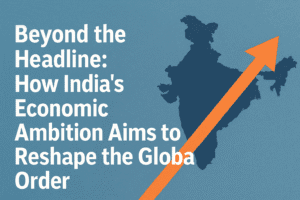Beyond the Headline: How India’s Economic Ambition Aims to Reshape the Global Order
Prime Minister Modi has positioned India as a pivotal force capable of reinvigorating the global economy, moving beyond its role as a regional power to a key international growth engine. This ambition is driven by a disciplined strategy of “reform, perform, transform,” which has fortified the nation’s economic fundamentals. With a clear vision to become a developed country by 2047, the government is unleashing next-generation reforms, like a simplified GST, to boost manufacturing and ease of business.
A crucial element of this plan is a direct appeal to the private sector to lead R&D in future-critical industries such as clean energy and biotechnology. The roadmap for achieving this self-reliance emphasizes unprecedented speed, scale, and scope, exemplified by its rapid 5G development. Ultimately, India’s immense and growing consumer market, stable governance, and innovative capacity present a compelling opportunity for the world, offering not just production capabilities but also vast demand and scalable solutions to shared global challenges.
When a national leader speaks, it’s often about domestic policy and local aspirations. But when Prime Minister Narendra Modi addressed a gathering of world leaders in New Delhi, his message was pointedly global: India is ready to be a primary engine for worldwide economic growth.
Guided by the now-famous internal mantra of “reform, perform, transform,” the speech was less a declaration of intent and more a statement of arrival. It painted a picture of a nation rapidly transitioning from an emerging market to a central pillar of the global economy, with a clear plan to leverage its position for mutual benefit.
The Three-Pillar Foundation of a “Developed India”
PM Modi’s vision rests on a triad of interconnected concepts:
- Reform: The government announced a “comprehensive new set of reforms,” with the next-generation simplification of the GST law slated for completion before Diwali. This move, aimed at reducing compliance burdens and potentially bringing down prices, is presented as a continuous process, not a one-time event.
- Perform: The speech was backed by a list of strong economic fundamentals: record capital market fundraising, robust forex reserves, controlled inflation, a strong banking sector, and the powerful domestic investment trend of millions investing monthly through SIPs. This data is the “perform” element—the tangible results used to validate the reform agenda.
- Transform: This is the ultimate goal—becoming a developed nation by 2047. The government believes the cumulative effect of reform and performance will transform India’s manufacturing capabilities, market demand, and both the Ease of Living and Ease of Doing Business.
The Call to Action: Beyond Government Alone
A crucial and often overlooked part of such speeches is the delineation of responsibility. PM Modi explicitly called upon the private sector to step up its investment in research and development. By naming sectors like clean energy, quantum technology, battery storage, advanced materials, and biotechnology, the government is signaling where it believes the next frontiers of economic growth and technological sovereignty lie. This isn’t just about manufacturing; it’s about innovating.
The “How”: Speed, Scale, and Scope
Perhaps the most insightful part of the address was the framework provided for achieving self-reliance—a concept he clarified is the basis for a developed India. He outlined three critical parameters:
- Speed: The rapid domestic development of the entire 5G stack and the early push into 6G technology were cited as prime examples.
- Scale: Leveraging India’s massive domestic market and demographic dividend to achieve economies of scale that are unmatched elsewhere.
- Scope: Applying this accelerated, large-scale approach to a wide range of sectors, from digital infrastructure to advanced materials.
Reading Between the Lines: The Real Value for the World
The subtext of PM Modi’s address is as important as the text. India’s proposition to the world is multifaceted:
- A Stable Alternative: In an era of global supply chain re-evaluation, India is positioning itself as a predictable, stable, and fast-growing manufacturing and investment destination.
- Demand and Growth: As hundreds of millions of Indians move into the middle class, they represent not just a workforce but a vast consumer market. A wealthier India imports more, travels more, and consumes more, providing a vital demand shock to the global economy.
- Innovation at Scale: The challenge of solving problems for 1.4 billion people often leads to innovative, cost-effective, and scalable solutions that can then be exported to other developing nations.
In conclusion, PM Modi‘s speech goes beyond political rhetoric. It is a strategic positioning of India on the world stage. By showcasing internal economic strength, a clear reform trajectory, and an ambitious vision for 2047, India is asserting that its growth story is no longer just its own—it is an indispensable part of the solution to pulling the global economy out of its current sluggishness. The world, it seems, is being invited to both invest in and benefit from the Indian transformation.

You must be logged in to post a comment.